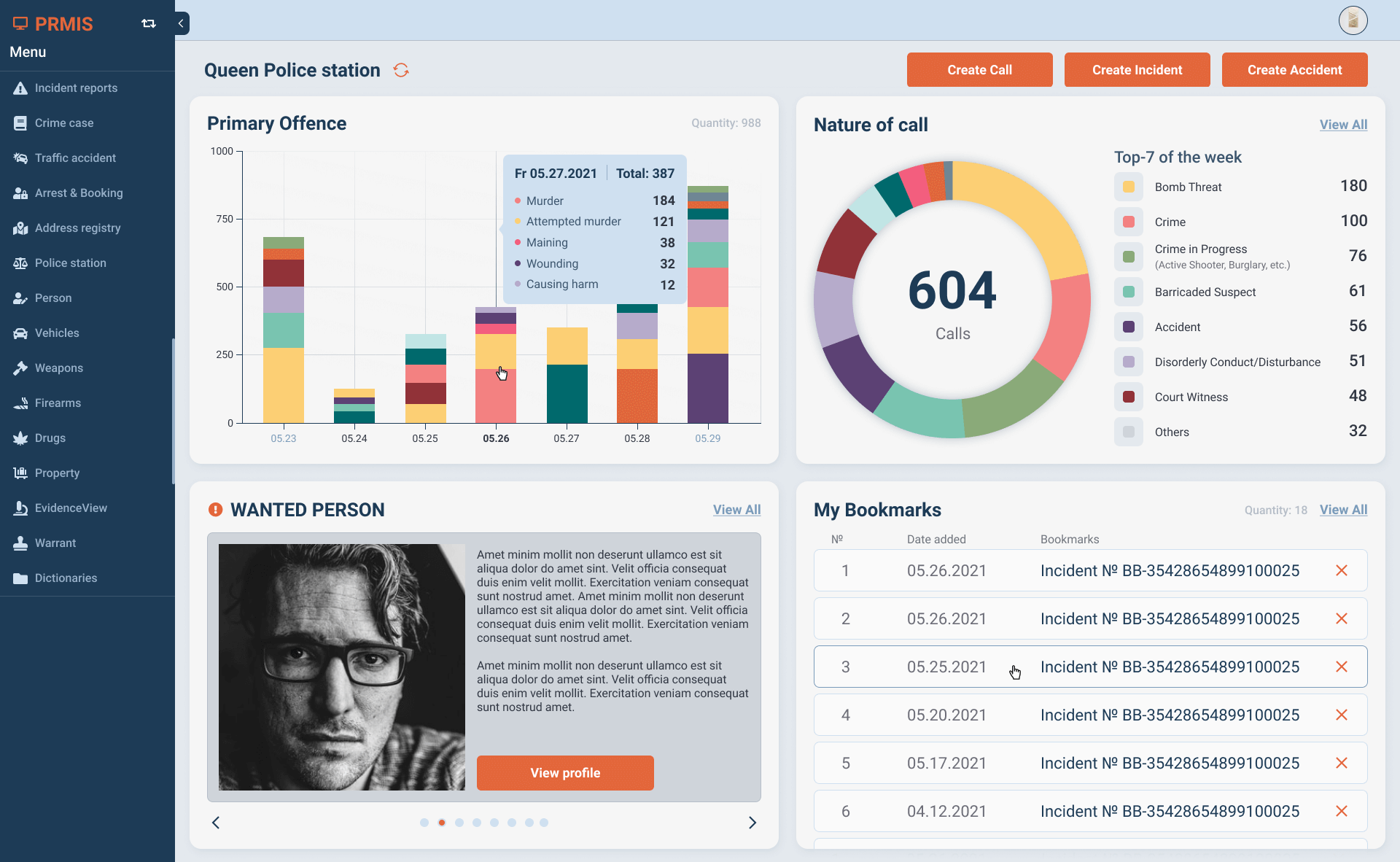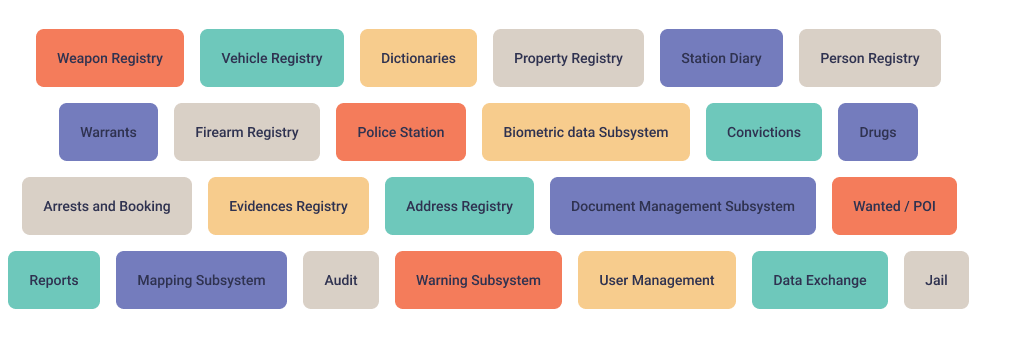About the Client
PRMIS is one of the products of the CariSECURE project “Strengthening Evidence-Based Decision Making for Citizen Security in the Caribbean.” The project is funded by USAID and implemented by UNDP Barbados and the Eastern Caribbean.
The solution was developed for eight Caribbean countries with a total population of more than 2.2 million. These countries include Grenada, St. Kitts and Nevis, St. Vincent and the Grenadines, Guyana, Suriname, St. Lucia, Antigua and Barbuda, and Barbados.
Challenge
Outdated approaches towards police information management have been a factor in delaying the development of law enforcement and crime prevention in the Caribbean region. The downside of the former police records management workflow included:
- Heavy reliance on paper documents;
- Lack of advanced tools for collaboration and data exchange both within a police station and between multiple police stations;
- Insufficient standardization of the data management practices at both national and cross-national levels.
Ultimately, the challenge was to improve the efficiency of operations and collaboration in policing by creating an integrated police records management information system.
Solution
The solution, a Police Records Management Information System (PRMIS), is a web application that allows officers to log, store, and exchange information related to various aspects of police daily routine: incoming calls, incidents, crime cases, traffic accidents, as well as logged pieces of information that relate to the above-mentioned operations.
What is more, the system allows proceeding with the investigation according to the workflows of the region, registering new data in a wide variety of modules: firearms, vehicles, drugs, persons, etc.
Key Features
The key features of the newly created police records management system include:
- Flexible user management and permissions assignment;
- Security and audit management;
- Documents/Files storage;
- Data sharing between police stations;
- Data export functionality;
- Multilingual support;
- Low hardware requirements.
PRMIS reflects information regarding all incidents with exhaustive information such as date and time, location, reporters, victims, suspects, investigators assigned, offenses type, and other related details. Apart from general information, the system comprises specific data logs of evidence, property, vehicles, weapons, and other necessary entries.
The system’s primary task is to make police stations’ work easier. So, what does this look like for the end user? An officer can log into the system at will. If the officer is assigned as an investigator, an email notification reminds one to log into the system.
After logging into the system, an officer can see their current tasks and select an Incident to work with. After that, an officer can input all required information about the Incident, such as involved persons, related items, offenses, or other data available about the Incident.
At the same time, it is possible to work with data available within various registries or to make new Incident-related entries into registries. For example, new witnesses are discovered. They can be added to the Persons registry and be linked to the Incident. Alternatively, witnesses can be added to the Incident, and the creation of the profile within the Persons registry based on the data added can be done as the second step. The same applies to other information: properties, vehicles, weapons, drugs, etc.
The system allows users to work with data directly: make new entries, update records, navigate through cases, export data, assign a case to another officer, or transfer a case to another station.
Flexibility was one of the top priorities for the Client. The number of parameters is not hard-coded. Entries from dictionaries can be used to create customizable dropdowns. For example, a dropdown for location types can be altered to make it easier for officers to describe a crime scene.
Officers can access a dashboard, which is also a homepage, with a summary of the current crime situation. The dashboard visualizes the number of calls logged, incidents, traffic accidents, and arrests registered for a specified period of time.

Station Dashboard: Overview
Also, creating a list of bookmarks for the required information is possible.

Station dashboard: Charts, Wanted, and Bookmarks
Security and reliability of entries. All entries are pass-through, and their accidental loss or damage is impossible. If malicious actors tamper with data, the system will log such activities for further investigation. Apart from helping each officer with daily tasks, the system helps collect statistical data regarding offenses and their types, traffic accidents, and other information to get an overview of incidents within a specific area.
Multilingual Interface. The ability to choose an interface language is important for the diverse Caribbean region. English and Dutch are the languages of the system. If needed, more language versions can be added in the future.
As a web application, PRMIS has low hardware requirements. An ordinary computer with an Internet connection is enough to access and work with police records.
The entire development process took less than two years, and the technologies included the low-code development platform Agora, Node.js, and Vue.js.
PRMIS Structure
PRMIS consists of four major modules:
- Call for service;
- Incidents;
- Traffic accidents;
- Crime cases.

PRMIS modules
The Call for service module shows a log of all calls registered by desk officers of the police station for further investigation. This module contains basic information such as time, the location of the crime, the circumstances of the crime, and other related details.
The Incidents module shows all the incidents initiated based on incoming calls or from scratch. This module contains information about the investigator, the evidence, the tasks, the documents, etc. Officers can supply this module with various details: vehicles, firearms, weapons, stolen and found items, and more. For further details, a link leads to a corresponding registry. As the investigation is finished and the available data is logged, a responsible officer can decide on the next step: close the incident, transfer it to another officer, or initiate a case. After the decision is submitted, the system processes the incident accordingly. Moreover, the module contains a detailed log of all actions taken on this incident.
The Traffic accidents module contains all the information related to vehicles and traffic offenses. Users can review the list of all the registered traffic accidents in one grid, discover related persons and vehicles, and check the investigation status of the accident and all the details. Similar to the previous module, Traffic accidents can be supplied with various details: accident details, vehicles, persons involved, fingerprints and others.
The Crime cases module summarizes the result of work with incidents and traffic accidents that were deemed a crime. This module contains records related to new/pending/closed crime cases. From this module, officers can access required registries with detailed information regarding involved persons, weapons, vehicles, etc. As the end-point of any case is its clearance, an investigator can, for example, close the case by indicating “cleared by arrest.”

PRMIS subsystems
Apart from the four modules, PRMIS includes a number of subsystems. These subsystems include Registries (Firearms, Vehicles, Property, etc.), Station Diary, Reports, and other logs containing certain types of data.
A Registry is a detailed log of all objects of a certain type. For example, the Firearm Registry stores all the information about the crime-related firearms of the region. The Firearm Registry displays firearms seized during an investigation or those appearing as evidence. In the registry, officers can find a firearm’s information: model, ammunition type, ownership, and more. The registry includes both text forms and photos. All the data can be exported (the grid is customizable) for investigation or reporting purposes.
The subsystems are interconnected, which means that changes in one of them will be reflected in the others. The following hypothetical situation can serve as an example of such interconnections.
An investigator discovers that a firearm associated with a crime is used by a specific suspect. If the suspect’s profile contains a record of using a firearm to resist arrest, the Warning subsystem will add a corresponding label. Also, it is possible to discover previous Incidents involving the firearm, as the Crime History tab within the firearm’s profile displays such information.
Security and Customization
The role-based access control model ensures that only authorized users operate with data. There are several roles with a pre-determined set of data access permissions. Such roles correspond with an officer’s role: desk officer, investigator, supervisor, station chief, etc. Also, the system allows creating an access role with a customizable set of permissions for a specific task.
Security audit functionality allows tracking user activity such as logins, actions, IP addresses, and security violations. A detailed log will help get information on who viewed or altered any data in case of a security breach. Also, the whole system is configured in a way that prevents access from unauthorized locations.
Apart from security configurations, there are various customization options to meet a specific country’s needs and requirements. For example, an administrator can change currency units and systems of measurements, create custom templates for documents, manage password policies, etc.
Results
The developed information management system contributes to the digital transformation of citizen security and policing of the Caribbean region. The benefits of PRMIS for the Caribbean police include:
- Data-driven policing resulting from the availability of real-time data for reporting, further analysis, and strategizing;
- Easier management of police records;
- Better communication and data exchange between officers working at the same station;
- Enhancement of cross-station interoperability. Transferring cases between police stations is automated;
- Standardization of police data management across eight countries;
- Introduction of advanced security and audit management capabilities that ensure transparency of information management.
Officers, who have already started using the system, have positive feedback regarding the application’s intuitive interface and simplicity of working with information.
PEOPLE ALSO READ

AI-Powered Permit Analyzer for Regulatory Compliance
Softengi developed an AI application that streamlines the review of complex permit documents.

Universal Data Lake Publishing Service for Large-Scale Data Publishing
Softengi successfully implemented a data lake publishing solution that addresses EHS vendor's critical data transfer challenges.

Mental Well-Being Clinic for Virryhealth
Softengi developed a virtual clinic with interactive and non-interactive activities where visitors could schedule therapy sessions with medical experts and visit a VR chat in the metaverse to interact with the amazing nature and animals of the African savanna.

